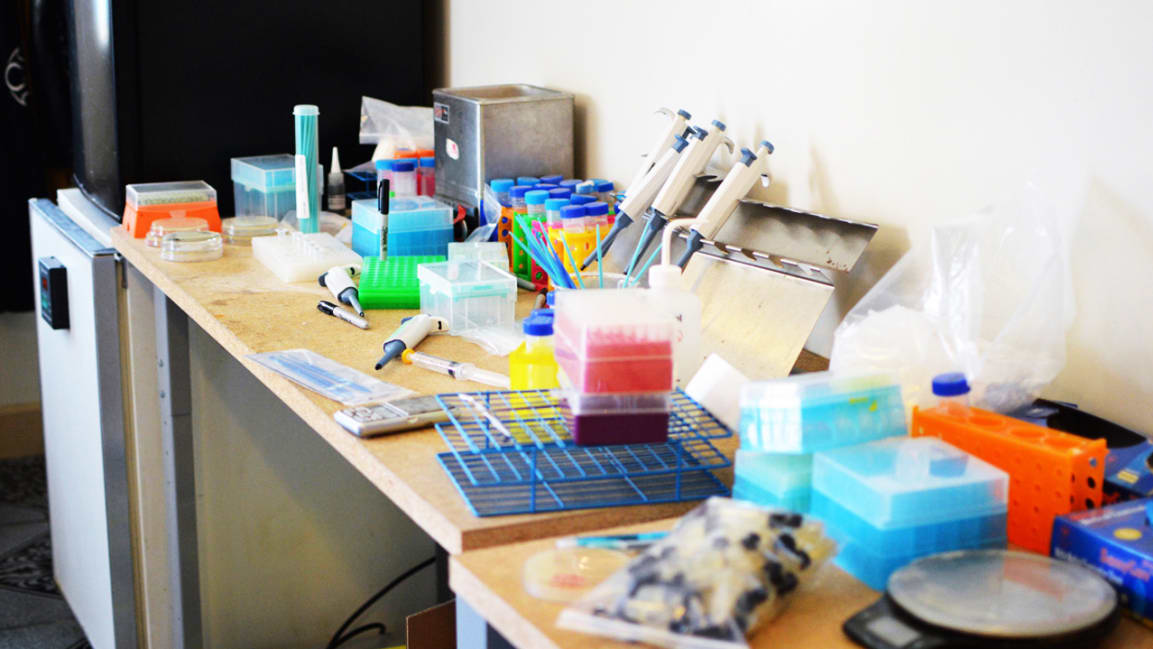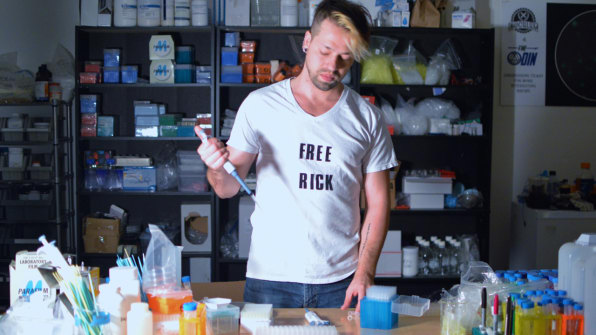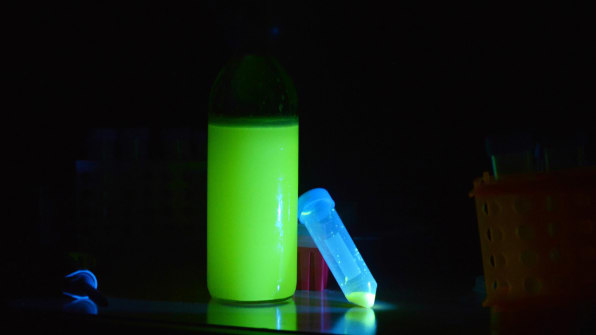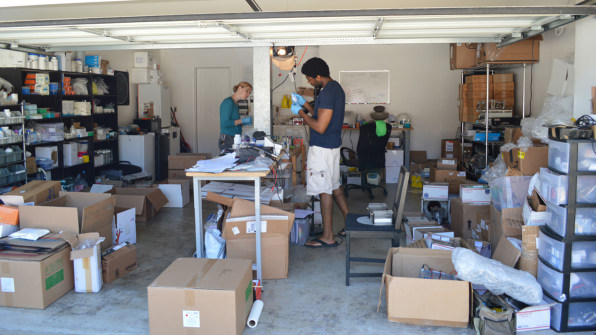Changing your own genes with just one injection - unless, of course, you are lucky

Biohacker Joshua Zeiner wants to create a world in which any person is able and in the right to experiment with his DNA.
“We have some DNA and a syringe here,” says Joshua Zeiner in a room full of synthetic biologists and other researchers. He fills the needle and inserts it into the skin. "It will change my muscle genes, and give me more muscle mass."
Zeiner is a biohacker, he is experimenting with biology in DIY, rather than in a conventional laboratory, ”spoke at the SynBioBeta conference in San Francisco with the report“ A Step-by-Step Guide to Genetic Self-Change Using CRISPR ”, where other academics in costumes and young CEOs of typical biotech startups. Unlike the others, he began his presentation by handing out samples and booklets explaining the basics of DIY genetic engineering.
')

Biohacker Zeiner spoke at the SynBioBeta conference with the report “A Step-by-Step Guide to Genetic Self-Change Using CRISPR”
If you want to genetically modify yourself, this is not necessarily difficult. When he offered samples in small bags to the crowd, Zayner explained that it took him about five minutes to make the DNA that he had brought to the presentation. In vitro was Cas9, an enzyme that cuts DNA at a specific location, oriented along the guide RNA, in a gene editing system known as CRISPR. In this example, it was developed to turn off the myostatin gene, which produces a hormone that limits muscle growth and reduces muscle mass. In a study in China , dogs with an edited gene had double the muscle mass. If someone from the audience wanted to try, they could take the test tube home and enter it later. Even dripping it on the skin, Zeiner said, you will get an effect, albeit limited.
Zayner holds a doctorate in molecular biology and biophysics, and he also worked as a research assistant at NASA for modifying organisms for life on Mars. But he believes that synthetic biology for editing other organisms or oneself can become as easy to use as, for example, a CMS for creating a website.
“You don’t need to know which promoter to use to make the desired gene or DNA fragment work,” he says, using some technical terms from genetic engineering. “You do not want to know which terminator to use, or the origin of replication ... The DNA programmer must know how to do it.” But the only thing you need to know is that I want the mushroom to be purple. It should not be more difficult. All this is quite possible - it’s just the creation of infrastructure and a platform so that anyone can do it. ”
Of course, a genetically edited application store has not yet been created. But a considerable number of biohackers have learned enough to - sometimes thoughtlessly - experiment with themselves. Several people whom Zayner knows, for example, began to inject myostatin for themselves. “It's happening right now,” he says. "All these things began to appear literally in the last few weeks." It is too early to say whether the injections of experimenters improved or caused problems, but some hope to see results in the coming months.
Despite the time spent in academic circles, Seiner is clearly not a typical researcher and avoids the idea that experiments should be limited to laboratories. When he started to communicate with other biohackers through the mailing list at NASA, and learned about the problems of those who wanted to do DIY work, it was difficult to find suppliers and they did not always send the necessary orders to those who did not have a laboratory - he was in 2013 started a business called The ODIN (Open Discovery Institute, and an homage to the Norse god) to send kits and tools to people who want to work in their garage or room. In 2015, deciding to leave NASA because he did not like working in their conservative environment, he launched a successful campaign to raise funds for DIY CRISPR.

“The only thing you need to know is that I want the mushroom to be purple. It should not be more difficult. "
In 2016, he sold $ 200,000 worth of products, including a yeast kit, which can be used to fuel glowing bioluminescent beers , a kit for detecting antibiotics at home, and a complete home laboratory for the price of a MacBook Pro. In 2017, he expects sales to double. Many kits are simple, and most buyers probably don’t use them to change themselves (many kits go to schools). But Seiner also hopes that as new knowledge is gained, people will experiment in more unusual ways.

Zeiner sells a complete home biohacking lab at about the price of a MacBook Pro.
He asks whether traditional research methods, such as randomized controlled trials, are the only way to make discoveries, pointing out that in a personalized medicine (such as cancer immunotherapy, which is personalized for each patient), the sample size of one person makes sense. In his speech, he argued that people should be able to experiment on their own if they wish; we change our DNA when we drink alcohol or smoke cigarettes, or breathe dirty city air. Many actions authorized by society are more dangerous. “We donate maybe a million people a year to car gods,” he said. "If you ask someone: 'Could you get rid of the cars?' - No. ”(Seiner experimented in different ways, including an extreme DIY feces transplant , which he said cured his digestive problems, he also helps cancer patients with DIY immunotherapy ).
If you change your DNA, you can then sequence your genome to see if the change has occurred. But the experiment in the garage can not provide as much information as conventional methods. “You can confirm that you have changed DNA, but that does not mean that it is safe and effective,” says George Church, a professor of genetics at the Harvard Medical School (which also acts as an adviser to Seiner, recognizing the value of the biologically literate public in the century biology). “Everything he does is telling you that you did the right job, but it can be dangerous because you also changed something else. This may be ineffective in the sense that not enough cells have been changed, or it is already too late, and the damage has already been done. ” If a child is born with microcephaly, for example, changing the genes in his body most likely will not affect his brain.
 img
img“We live in incredible times, when we study a lot in biology and genetics thanks to CRISPR, but we still don’t know much about the safety of human cell editing using CRISPR.”
Anyone who wants to introduce modified DNA to himself risks without enough data, or perhaps any real data — about what might happen to make an informed decision. This, of course, goes without saying: do not try to do this at home. “We live in incredible times when we study a lot in biology and genetics thanks to CRISPR, but we still don’t know much about the safety of human cell editing with CRISPR,” says Alex Marson, a researcher in microbiology and immunology at the University of California in San Francisco and CRISPR expert. "It is very important that it passes through rigorous and proven safety tests in each case, and is done in a responsible manner."
In Germany, biohacking is now illegal, and a person conducting experiments outside a licensed laboratory may receive a fine of € 50,000 or three years in prison. The World Anti-Doping Agency now prohibits all forms of gene editing in athletes. However, in the US, biohacking is not yet regulated. And Seiner doesn’t think he should, he compares fears that people are learning how to use synthetic biology with fears of learning how to use computers in the early 1980s. (He quotes a 1981 interview in which Ted Koppel asked Steve Jobs if there was a danger that people would be under the control of computers.) Seiner hopes to continue helping as many people as possible to become more “competent in DNA”.
“I want to live in a world where people genetically modify themselves. I want to live in a world where all these cool things that we see in science fiction television shows are real. Maybe I’m crazy and stupid ... but I think it’s probably possible. ”
That's why, he gave himself an injection in front of the crowd at the conference. “I want people to stop arguing about whether CRISPR can be used or not, whether it is normal to genetically modify oneself,” he says. “It's too late: I made the choice for you. The controversy is over. Let's continue. Let's use genetic engineering to help people. Or give them a purple skin. ”


Source: https://habr.com/ru/post/371015/
All Articles